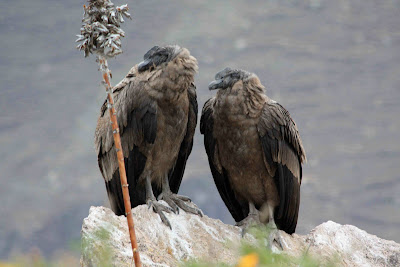Not only is Arequipa the most tranquil and pretty places in Peru, it is also close to a canyon more than twice as deep as the famous Grand Canyon in the United States, called Colca Canyon. That statistic alone makes you want to take a look. Coupled with this chance to see some natural wonder is the chance to do a bit of bird watching while you're there. There is an area called Cruz del Condor high up overlooking the canyon, a spot where condors like to hang out and where you can hang out to watch them.
Wanting to save some cash we decided against one of the many tours from Arequipa. Instead, we took a bus to Cabanaconde, a small town within the Colca national park. The idea was to head to this town, stay over and then get up early to go see the condors, a short journey away. Seems reasonable enough, but we hadn't really considered how much time we would spend on an uncomfortable bus. The bus to Cabanaconde from Arequipa took a long long time. A good seven hours I believe, which was more than the five the tourist office reckoned and more like the eight our guide book approximated.
The bus makes a stop at a town called Chivay and this is where you are asked to pay thirty-five Soles to enter the national park. I felt a bit wary of this. Not only because it is very expensive (a double room for the night would cost twenty), but another traveller had told us that park rangers try to get you to pay this when you're attempting to get a snap of a condor and that you don't really have to pay it. I also found the manner in which this tax was being enforced a little distasteful. There was no official ticket office. A woman simply stepped on the bus and looked to single out the white faces. Once she saw us, she came straight up the aisle and asked us to pay. Had she passed by any other folk on the bus up for a bit of tourism? Who knows. They all looked suitably Peruvian, but how can one operate a policy based on crude appearances? I immediately wished I'd dressed as an old indigenous woman. It would have been easy, just some face paint and copious layers of patterned material would have done the trick!
Maybe I overreacted when I challenged this setup. I don't mind paying my way, and hopefully, if it goes to the right people, it is a good thing for a relatively poor community. I just didn't like the way it was done, nor the disproportionate cost. We did eventually hand over the cash as the bus wasn't going anywhere until we'd paid.
By the time we entered the canyon area it was dark and we couldn't see anything out of the windows. Once we eventually pulled in to Cabanaconde all there was to do was to get a room for the night and eat something hot, as again we found ourselves in a cold place.
The next morning it was one big fight to get on the 6.30 am bus that would drop us at Cruz del Condor in time to see the birds in flight. Not only were there many a tourist doing the same thing, there was also a dozen local women wanting to get there too, so that they could set up their souvenir stalls. There was a fair amount of pushing and shoving but by ten past seven the very full bus started the fifty-minute journey to Cruz del Condor.
Once at the look-out, we were soon accosted by rangers, but were able to produce our tickets bought the day before. We found a good spot and waited. It was cold, and only a few intermittent breaks in the cloud allowed us the comfort of some early morning sun. After three quarters of an hour or so we spotted the first condor. It circled the vast area between the canyon walls and gave everyone a good view of its impressive wing span. Soon, three or four more appeared and made everyone feel the early start had been worth it. I took advantage of the continuous shoot mode on my camera as well as the telescopic lens and captured a good few hundred photos. That would be great fun to edit later!
We got what we came for, so technically it was a successful trip. However, I was still left wondering if it had been worth it. Perhaps if I was more into bird watching there would be no question. But take a look at the photo below - not exactly the most attractive creatures you're ever likely to see. I felt glad that we had gone to see the canyon, but most of that was done through a dirty bus window. We had to make the long ride back to Arequipa in time for our Lima-bound bus that evening, so there was no time to hang around.
Country Notes and Tales From Travellers
13 years ago













